18 Bronzemen, Return of the 18 Bronzemen, Shaolin Kung Fu, The Shaolin Kids (1974, 1975, 1978)
Directed by: Joseph Kuo
Written by: Chien Ting, Hsin Yi Chang, Joseph Kuo, Tse Hsiao
Starring: Carter Wong, Chiang Lung-wen, Hung Yi, Polly Ling-Feng Shang, Shang Kang, Tien Peng
CINEMATIC VENGEANCE [1974-79] – 8 KUNG FU CLASSICS FROM DIRECTOR JOSEPH KUO [Limited Edition Box Set, 2000 copies]: On Blu-ray now, from EUREKA ENTERTAINMENT
Carrying on from my review of the first half of this boxset, I continue my journey into martial arts movie fun and madness!

DISC THREE
SHAOLIN KUNG FU [1974]
AKA SHAO LIN GONG FU
RUNNING TIME: 91 mins
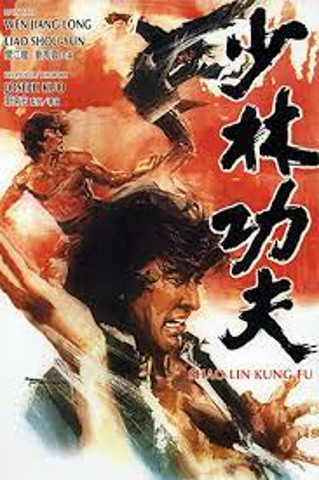
Lin Fung works for the local rickshaw company and just about make enough money for him and his blind wife Xiao Yung. Things seem to be especially good when he takes Miss Bei, a prostitute, to her home and she offers to make him her regular driver and pay him more than he’s used to. However, the dastardly Master Chu has just come into town and formed his own rickshaw company. Using intimidation and even violence, Yang’s men begin to dominate the clientele. Due to his father having been killed in a fight, Fung promised his mother that he’d never fight, and Xiao Yung seems determined that he continue keeping his promise, while Overseer Ho also wants to avoid violence. But such a thing is impossible to stick to, and soon he’s sticking up for his colleagues and even the townsfolk, but Yang is willing to go to any lengths to get rid of Fung….
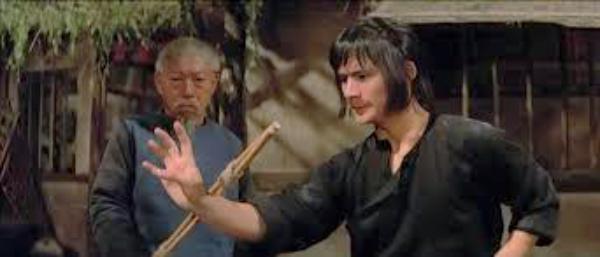
Despite its very generic title, there’s not one single mention of the word “Shaolin” in this film which, for the first time in this set, deals with the oft used premise of a hero who either doesn’t want to fight or has been told not to fight, though Fung here is only able to wait for the second brawl before he gets in there. Also for the first time in this set, it doesn’t showcase any new or interesting styles; hell, there’s not even a training sequence, though there sure appears to be some footage missing between Fung’s first fight, where he’s bested easily, and his second only a few minutes after, where he’s suddenly super strong, the usual punching and kicking sound effects made even louder. Made a few years earlier than the previous films, it looks and feels a bit closer to much of the Shaw Brothers stuff, with much more use of its main set and practically no comedy at all as we’re made aware that our hero is in an inescapable situation; if he doesn’t fight back things will get even worse for everyone else, but if he does he’s broken his promise and matters will just escalate. Unusually there are three main female characters, though their frequent use of punching bags may have even been too much for Sammo Hung, yet you have to admire the gal of a movie which – SPOILER ALERT – kills off all three of said female characters – SPOILER END. I don’t know if the budget was any higher, but Kuo and cinematographer Chen Tung make this the best looking film in this set so far. And this was made before the era of rapid zooms in the genre!
There’s a nice opening where we see the main street of the town empty before cutting to it full of people. Fung is first seen talking to a woman who’s fixed his cushion, Xiao Qin Luo, the daughter of his boss Master Luo, and is also soon making friends with prostitute Miss Bei. One may expect things to happen between Fung and one or even two of these ladies, or at least be tempted, but neither of these things take place, good old Fung being totally in love with his wife Xaio Yung, even though she keeps expressing her disappointment at him fighting and noticing when he’s just come back from a brawl despite being blind. One wonders why he didn’t just tell her that he got the bruises and scratches because he actually wasn’t fighting. But we understand how he’d want to do something when Yang’s men, led by Cui Bao, are not just taking rides off him an his workmates but beating them up, and even hassling other people including a young boy named Chu Tien-Hai, who also gets hit a fair bit. Closeups of Fung’s agonised face make it clear how much he wants to partake in the first fight which becomes a street brawl, and in the second he just can’t help himself. Overseer Ho visits Chu’s headquarters where Chu pretends not to know the trouble his men are causing and suggest they make pace, but the trouble continues. Fung keeps on winning for a while, even besting attackers when having had a lot to drink, but then Chu’s son Chang Pen tries to rape Xaio Yung. Fung understandably kills him, and we’re unusually allowed to spend a bit of time with Chu and feel his grief, though he then kidnaps Yung. Some quite intense and even grim moments follow, with the odd surprising and even shocking event or two. Screenwriter Tse Hsiao really piles it on including two rather peculiar deaths, and we’re made to realise that things would have indeed been better if Fung had kept his promise.
Star Chiang Lung-wen, who seems to have been asked to think of Bruce Lee without directly imitating him, definitely has some solid martial arts skill, but because it’s mostly fairly basic- if very precise – moves it’s not particularly exciting or interesting to watch and there’s little escalation of his mastery; he has this powerful finger death touch near the start. He does do increasingly amazing jumps which jar with the leaning towards realism, even though it’s common in these films to have characters do leaps thanks to a trampoline that they wouldn’t in real life be able to do, something which irritates some fans though it’s a carry on from Chinese folklore where great warriors were indeed able to do certain things that the rest of us couldn’t, something which was showcased even more a real years later where the modern phase of the wuxia subgenre began and wirework allowed performers to be able to jump around all over the place, indeed fly, for short periods. After Chung has leapt across a lake in one bound, you know that something’s gone a bit wrong when the climax stops the actual fighting and instead has our villain in a boat wondering where our hero is gong to leap out of the sea next. The best fight is halfway through in a quarry with people doing dangerous rolls down rocky hillsides. The music score includes some surprisingly lengthy excerpts from Lalo Schifrin’s Enter The Dragon and a short one from Akira Ifikube’s Daimajin. Shaolin Kung Fu is distinctly average, but that’s still fine for lovers of the genre, and it can’t help but have a certain power in places due to the nature of its plot and certain events that take place in it.
Rating: 









SPECIAL FEATURES
Original Mandarin audio track
Optional English dubbed audio
Brand new audio commentaries on Shaolin Kung Fu and The Shaolin Kids with action cinema experts Mike Leeder and Arne Venema
This track is as lively as ever, even if it spends even more time on detours than before. It would have been nice, for example, to here the pair mocking the use of the Enter The Dragon soundtrack, yet what they do in to is still always of interest, especially regarding the practises of the Hong Kong and Taiwanese film industries, while Leeder talks of how rickshaw drivers were relegated to being old men when the government, trying to get rid of them, refused to create any more licences; he and his mates would often get drunk and pay the drivers to be their passengers on their own rickshaws. They defend the fighting, saying that the film was made before things got goo; I guess they have a point though I’ve seen much better from the period. Apparently people rarely own up to seeing Bruceploitation films. It seems that some releases of these movies are coming up, unless I interpreted it wrong. Please let it be so!
THE SHAOLIN KIDS [1975]
AKA SHAO LIN XIAO XI
RUNNING TIME: 90 mins
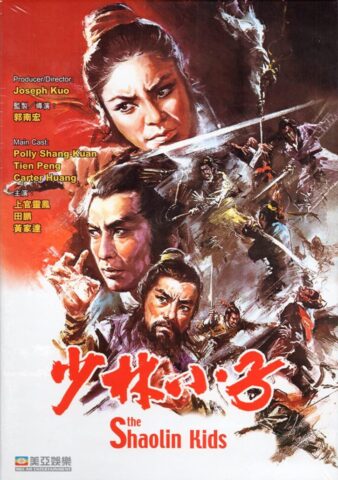
The Prime Minister of China Hu Weiyung is both ruthless and ambitious. Those who oppose his tyranny and corruption rend to be bumped off, and even those who do his dirty work stand a good chance of being killed too so they don’t tell anyone. His latest victim is former political opponent Mr Lui, who dies poisoned in the hands of his stepdaughter Miss Lui, who swears revenge and has the help of Mr Lui’s son Lu Tang. The two seize a self-incriminating letter from Weiyung revealing his plans to take over China with the help of the Mongols, but in return Weiyung kidnaps Miss Lui’s father Daoyuan….
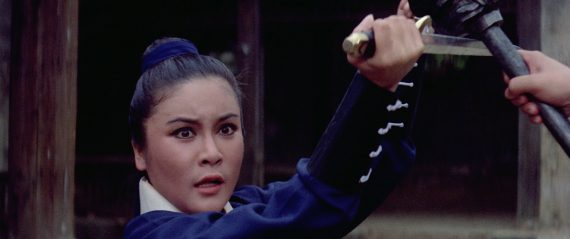
Well at least there’s a bit of referencing of the Shalin Temple in this one, though it’s brief and easy to miss if you’re not concentrating. And there aren’t any kids around at all, in what is nothing to do with the better known The Kids From Shaolin from 1984.. Still, the earlier time period setting and rich mileau enables The Shalin Kids to be much more colourful visually than the previous films in this set, with some opulent costumes and bright colours. Fighting-wise it’s a bit of an improvement on the last two, and for once allows a female lead to shine as much as the male lead; in fact I’d say that she’s able to shine a little bit more, Polly Ling-Feng Shang was in a lot of similar movies, most notably Dragon Inn, but doesn’t seem to be much thought of these days unlike, say, Angela Mao. The action isn’t dissimilar to the action in that film either, emphasising swordplay with a dash of other weaponry and unarmed combat. The tone is probably even more serious than the previous film, the only particularly goofy touch being these Life Saving Golden Pills that two characters pop whenever they’re injure whereupon they suddenly heal; this subplot comes to a most amusing but appropriate end. The story is much more political and large-scale than we’ve seen before, though of course the low budget can’t really support it properly.
Over opening shots of martial arts students practising we get the Wong Fei Hung film for the second time in this set, and just as inappropriately; in fact I reckon that some audience members at the time would have been offended by its use, even though the piece wasn’t originally written for the character. In fact nearly all of the music score is made from sections of the piece, or variations of said sections. We’re immediately shown what Weiyung is like. “Your son has killed two innocent men,” her growls at somebody, “How do you propose to punish him”? The reply, which isn’t funny really but which I couldn’t help but laugh at, is, “ I’ve beaten him severely. Right now he cannot walk. And, if it happens again then I will beat him to death”. Okay then. “Kill your son” is the reply from Weiyung. Then we cut to a chess game played by two of Weiyung’s political opponents; one leaves secretly when Weiyung pays a visit but the other who’s house it is stays. Weiyung has brought a doctor to give him some medicine for his painful ulcers, but it’s actually poison, after which Weiyung kills the doctor too. Miss Lui of course wants revenge for the death of he stepfather, and, despite her grandpa saying she could carry out her vengeance “With wits, not force”, she’s soon besting loads of Wieyung’s men sand even marching up to his fortress with her stepbrother Lu Tang and grabbing this letter. “Find them even if you have to kill everyone in the city” orders Weiyung to his second-in-command. His targets are already on a mission to rescue her kidnapped father, and again we have the trope of nobody realising that Miss Lui is a woman even though it should be bleedingly obvious. After what turns out to be the final fight, it seems that we’re going to get another one, but instead the story resolves itself in another way which is far more believable but which will disappoint some who expect the final ten minutes or so of a film like this to be dedicated to fighting.
The swordplay is fairly well staged if perhaps not varied enough. Still, the final fight is pretty good. Throughout the film, we’ve had these two characters named Earth and Sky [or Heaven and Earth is you watched the Mandarin version with English subtitles] being built up, and when we eventually we see them go into action, they’re thrilling to watch as they seem to get their strength from he earth and the sky and are a true team, using each others bodies and movement to aid their own, while our hero and heroine are finally having some trouble and have to resort to – well – it’s not really cheating [after all, this is in a genre where the good guys can gang up on one bad and it’s considered okay] – but they certainly have to think on their feet. Shang Kang is quite likeable and Ling- Feng Shang really has a presence, while Yuan Yu is mostly hissable but is given one bit at the end when he cries as he releases that the end is nigh, perhaps something that we could do with seeing more from villains as I’m sure it’s something that they do. The most familiar face to most will be Carter Wong, though his character is killed off quite soon. Mike Leeder is right; Kuo doesn’t seem to really have a directorial style. Here it’s more classical than the later efforts that are on these discs, but then it was made earlier so it probably would be. But he turned out a really solid and generally well made, if unremarkable, piece here.
Rating: 









SPECIAL FEATURES
Original Mandarin audio track
Optional English dubbed audio
Brand new audio commentary with action cinema experts Mike Leeder and Arne Venema
Their last track is true to form. The pair clearly enjoy this film and provide lots of appreciation while going into other things. There’s a particularly great story about Sammo Hung when he was being pushed in a wheelchair after an injury. His pusher buckled at pushing him across a three-foot river, so Hung got up and jumped across! They defend physical media[yay!] and make a good point about Asian films having lots of tough female fighter heroines way before Hollywood.
DISC FOUR
18 BRONZEMEN [1976]
AKA SHAOLIN SI SHI BA TONG REN
RUNNING TIME: 97 mins [Hong Kong version/ 95 mins [Japanese version]
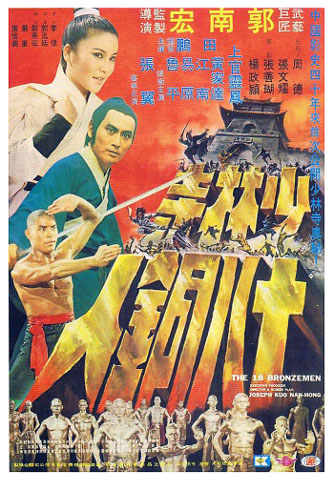
While on the run, young Tang Shaolung, who’s parents have been killed by men led by the wicked General Kwan because they opposed the tyrannical Qing government, is taken to the Shaolin Temple by his grandmother for his safety. There, despite the severe, disciplined lifestyle, he grows up to become a skilled student in the martial arts. He also befriends Brother Teijung, who’s also lost his parents to the Qings. Eventually he concentrates his sights on leaving Shaolin to avenge his father’s death. However, to ‘graduate’ from Shaolin means to defeat the Shaolin Bronze Men and a series of similarly fiendish tests….
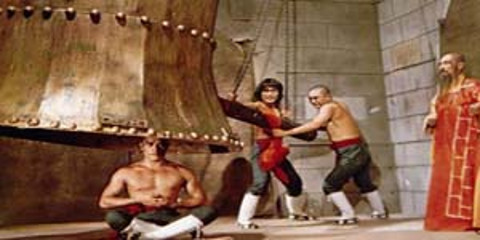
It seems that, actually, the Shaolin Temple never actually used “wooden men,” much less “bronze men,” to train martial arts practitioners, nor did they have booby-trapped hallways full of springing spears and falling stones. Oral legend seems to have been the source of such stories, and – well – it’s usually nicer to print the legend. Probably the highpoint of the first few films that stared Jackie Chan in the middle of Shaolin Wooden Men, where he shows his utter mastery of various animal styles as he fights his way through a gauntlet of wooden dummies which are quite obviously people in suits, yet it doesn’t matter much because we’re being thrilled by the skill on offer. But Joseph Kuo did it before. His film is certainly similarly structured, with a training-filled first half followed by a second half set outside the temple where vengeance propels the plot, but Kuo makes the Bronze Men sequence far longer and more elaborate, as our two heroes go from room to room, battling not just men in head-to-toe robotic outfits which actually look more gold than bronze, but also topless men whose skin is painted gold who fight with swords, sticks and unarmed combat. While neither Tien Peng nor Carter Wong are quite as brilliant as Chan was even in 1976, the sequence is still thrilling stuff, at times as much like dancing as it is fighting, though that’s not to say that there isn’t some pain or blood, such as when Peng keeps on getting whacked with the end of a staff. The problem here though is that we have a film whose main reason to exist is over with almost half of the running time still to go, and nothing afterwards comes anywhere near it, though, after all the fighting I’ve watched over the last week and a half, I rather enjoyed seeing a solid story being allowed to progress without constant interruptions to brawls, and most of it’s pretty well handled.
18 Bronze Men actually exists in two quite different versions. Because they couldn’t find the original elements, Eureka had to piece together the original cut from several different sources, but that was the version I opted to watch seeing as the audio commentary was over the fully restored Japanese version anyway and the latter didn’t have an English dub option. This means that a few things in this review only apply to the Hong Kong cut, but you will find a a brief overview of the differences later. Here, we open with Tang being dropped off at the Shaolin Temple by his grandmother and partly learn why, though the full story isn’t told until much later with some nicely cut in flashbacks, one of which shows someone using a sword while also holding a baby under his arm. And at last in one of these film we get opening titles with the star demonstrating his skills behind them, though he’s soon replaced by loads of Bronze Men. 20 years later and Tang is still finding it hard, but then this is a place where, for example, if you struggle to lift a weight and it hits and hurts you, the ginseng your friend offers you to soften the pain may be taken away by one of the senior monks. And a trial where you sit right under a bell which somebody keeps on ringing is more like proper torture. Tang and Wan’s first go at the Bronze Men, one of which has a face like Alfred Hitchcock [I kid you not], isn’t a success, and General Kwan sends a ninja to kill him. But he finds a book in the ceiling called the Secret of the Lohan Fist, so he’ll succeed next time. Once out, he finds his uncle to tells him who he really is and gives him half of a royal seal, the other half belonging to his future wife. And guess who the woman following him around who everyone mistakes for a man [even though she doesn’t look at all like one] and who he doesn’t like is?
Fights are fairly short and not numerous in the second half, but the final duel, which is a three-on-one battle, is pretty good; it’s not too smooth, but it does well by showing how the three good folk have to learn how to work as a team to best their powerful opponent, though we never see Kwan fight before so he’s not built up as a fighting threat. Polly Ling- Feng Shang from The Shaolin Kids [Kuo sure liked to use the same actors and it’s rather nice to see the same one turning up twice or more] again shines, though here her kung fu relies as much on superhuman, trampoline-assisted, leaps as it does on kicks. Tien Peng is quite obviously not as good a fighter as Wong and not as good an actor either, but is able to pull off his character’s emotional journey fairly well. He and Ling-Feng Shang are great together in their first meeting scenes which have a real spark to them, though elsewhere this is another serious affair which also has a proper musical score rather than a collection of mostly pirated cues. Kuo seems to pay more attention to non-fighting scenes than usual, such as the reunion with his uncle; it takes place is a nicely lit set and has some atmosphere to it. Yet the economy of storytelling that’s common in this genre is still present in a great moment where people are fighting in a street, talk about relocating to beside a mountain and in the next shot they’re fighting by a mountain! I liked a lot of aspects of 18 Bronze Men, but let’s face it, it’s really about the Bronze Men stuff, and this film would be worth the price of inclusion just for that alone.
Rating: 









SPECIAL FEATURES
THE JAPANESE VERSION
Much of the commentary is spent talking about the differences so there’s little need for me to go into detail, but Kuo really did an extensive re-editing job for the Japanese market. Again we have the Wong Fei Hung theme, then an opening narration comprised partly of footage from a different film. Flashbacks are now relocated to the beginning so everything plays chronologically, then we get at least 20 minutes more footage from no less than three other Kuo films to show our either our two main characters growing up under strict martial arts training or just one of them which is Chung, because Wong’s role is significantly beefed up throughout, with even some new footage of him being shot. In return most of the original scenes are slightly shortened, with Ling-Feng Shang’s role particularly suffering. Some of the editing is well done but the cobbling together of footage in the early section is clumsy and leaves a few continuity errors, and in general this version doesn’t flow very well, a shame as it’s the more widely seen cut and is the one that’s fully restored.
Original Mandarin audio track
Optional English dubbed audio for Shaolin Kung Fu, The Shaolin Kids, and Return of the 18 Bronzemen
Discs 3 and 4 – Newly translated English subtitles
Brand new audio commentary with Asian film expert Frank Djeng and film writer John Charles
Djeng is paired with a different person for his last two tracks, and I think they sound better together, even though much of this one consists of Charles pointing out what’s been added or cut to Djeng, who hasn’t seen the Hong Kong version and is therefore constantly surprised and even at one point confused at all the changes that were made. Apparently 40 minutes was cut from the original and 35 minutes added. Charles seems to be the greater expert on the film or at least Kuo, but Djeng is probably more knowledgeable on these films in general, and does his usual interesting digressions, such as why some Shaolin students have hair and some don’t, or a great story about Kuo being questioned by the Taiwanese government who said that he couldn’t make any films because he seemed to be pro-Chinese. A baffled Kuo asked why and was told that a shot of some stars in one of his films resembled the arrangement of the stars on the Chinese flag!
THE HONG KONG VERSION
Now here’s the thing; this version has been assembled from what several different prints and some of them didn’t look that good. For a couple of scenes the film is in full screen! The alternating between the digital restoration of the Japanese cut and the others will be jarring for some viewers who will prefer the former version for that reason. It’s such a shame that the superior edit couldn’t be restored because there are no original prints left, but I shall still probably watch that version more often anyway, and kudos for Eureka for doing what they could here.
Original Mandarin audio track
Optional English dubbed audio
RETURN OF THE 18 BRONZEMEN [1976]
AKA YONG ZHEMG DA PO SHI BA TONG REN
RUNNING TIME: 93 mins
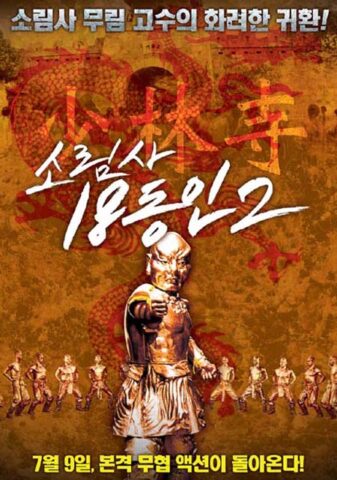
Ai Sing Chueh is the Fourth Prince in the hierarchy of the Qing empire, and when the old Emperor is about to succumb to illness, he forges the ruler’s will and makes himself emperor following his death. However, he then hears that the Shaolin Temple is a hotbed of the resistance, and an encounter with a blind monk selling small bronze statues while out among his people incognito, not to mention being bested by a lady, gives him the idea to learn martial arts. Then he rescues a woman from some thugs and despite fancying her escorts her to her husband, but when he sees the husband practicing Shaolin kung fu, Ai decides to challenge him. When he loses, he becomes obsessed with obtaining the same superlative skills as well as getting a sense of the burgeoning rebel movement, so, again keeping his identity secret, Ai Sing decides to train as a Shaolin monk, though the temple only takes as its students people under 14….
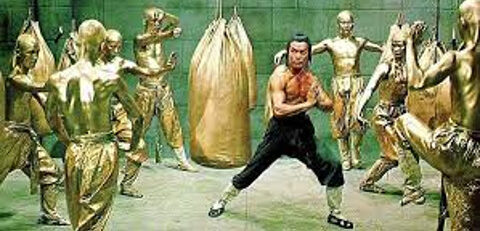
Though obviously filmed on many of the same sets which would suggest a cheaply made follow-up churned out just to capitalise on the success of 8 Bronzemen, this sequel betters its predecessor in two ways. The first is that even more of the running time is devoted to the many trails that its hero must face, with a greater number and variety of threats. We get the expected huge armoured bronze guards, bronze-covered people with swords, spears and staffs and moving walls, plus a reply of that savage beating by a pole, but also things like a huge bronze bell which, instead of being rang while the trainee is inside, is repeatedly pushed into the fighter’s back and is even shown to be fatal. And then there’s the test in which the fighter has to sit in the middle of a circle with his eyes closed and identify the direction to which coins are being thrown through his hearing alone – if he fails, a huge stone block is dropped on his head! The Shaolin Temple sure is a brutal one here, with several instances where we see student’s bloodily dying. It’s a wonder anybody studies there at all. The other way it which it bests the first film is in giving us a more interesting protagonist. In fact I don’t think that many martial arts films had as its main character not just a member of royalty but a villainous person, a conniving cheat and murderer who aims to eventually destroy the place where he’s studying the martial arts, meaning that you’re unsure as to how things will end. It’s possible that some viewers won’t like having a hero to root for, but I really enjoyed not being sure whether I wanted Carter Wong’s character to succeed in his training or not. On the debit side, Tien Peng and Polly Ling- Feng Shang return but in little more than cameos, though the latter suddenly features in the climax.
The Emperor is ill, and Ai Sing is not happy with his will, but an aide says that it can be altered, so this is done, and Ai Sing orders another aide to ensure that there’s no opposition to this. After the funeral, the will is read out, and the reader is surprised by the alteration, but is then killed by a ninja who Ai Sing then slays when he says that he ordered him to do it. They really make out this guy to be nasty, which is very brave seeing as he’s also the main character, though after much begging he does spare someone’s life. However, he’s concerned that the Shaolin Temple wants to rebel. Now we join Ling- Feng Shang, who’s unnamed like most characters, is in a restaurant. She lets some of Ai Sing’s men have the meal that was meant for her which they demand, but won’t take it when the waiter is struck and defeats them in a fight before then going to fight Ai Sing – who of course isn’t wearing any disguise yet still nobody recognises him – who loses, then soon after that loses again to the husband of a woman he saves. So he knocks on the door of the Shaolin Temple but is made to wait outside for three days and three nights before he’s let in, and even then he has to must transport 500 gallons of water and 500 pounds of wood for a period before he’s actually accepted and taught the Buddha Style, though he also wants to learn the Da Ma 18 Principles which is the only way to beat it, and isn’t allowed so he sneaks into the library at night to learn everything else. He also does the old chestnut of putting his fingers into a huge bowl of burning bits of rock over a fire. He tries and tries again to get though the Bronze Men, and you have to admire his determination. This stuff ends in an odd twist, by which then we only have ten minutes to go.
Carter Wong excels throughout; at times he looks as exhausted for real as his character is. What with Peng and Ling- Feng Shang playing a married couple, one could conceivably see this as a proper sequel to 18 Bronzemen if you think of Wong as playing a different character. All three get to fight each other in very well staged and choreographed duels indeed. The climactic Wong/ Ling- Feng Shang fight seems rather thrown in there to add an action scene to the final act, but it’s one of the best male/female set battles of the period; we really get a sense of masculine versus feminine rather than having the woman imitate a man, though I’m sure that we needed the woman to have some odd weapons, most notably a sword that can shoot other sword-blades. And I get the sense that screenwriter Tien Ching wasn’t sure how to end his interesting setup, though I really like his conclusion anyway. We get some news and a mention of what in the subtitled version is that favourite the flying guillotine, before finishing on a closeup of Ai Sing thinking. We’re meant to properly take in that his campaign against the Shaolin Temple is not just political but is now personal. Kuo tried to give us a sequel which provided more of what people liked while also at the same time going down a different path or two, and he succeeded in achieving this.
Rating: 









SPECIAL FEATURES
Original Mandarin audio track
Optional English dubbed audio
Brand new audio commentary with Asian film expert Frank Djeng and film writer John Charles
Both Djeng and Charles think this to be superior to the original; I’d rank them about the same, though they’re basing their opinion on the inferior Japanese cut of 18 Bronzemen. Among loads of new interesting related and not so related facts are that part of this film is based on fact [with much explanation of the calligraphy element] with this cruel Emperor being the only one ever who learned martial arts. We also hear that the original was released in Hong Kong one week after this sequel, and that Chinese audiences tended not to like Enter The Dragon because of inaccurate ethnic aspects like Chinese fighters in karate suits. One can sense how the two are loving the action that’s taking place on screen. A fine track to finish this set on.
SET SPECIAL FEATURES
8 Films across four Blu-ray discs, all fully restored and presented in 1080p HD
All four of these films look stunning, with fine colour balance, image depth and grain balancing. Excellent work.
Limited Edition Hardbound Case featuring newly commissioned artwork by Darren Wheeling
Limited Edition 60 page booklet featuring new writing on the films included in the set by James Oliver, illustrated with archival imagery and materials
Limited Edition set of 8 facsimile lobby cards
Eureka Entertainment’s set Cinematic Vengeance is an essential purchase for martial arts movie fans, while newcomers get a good and quite varied delve into the genre. Highly Recommended!


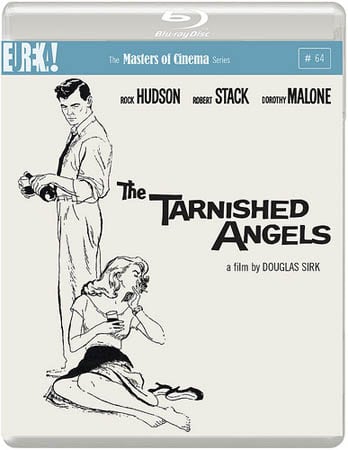
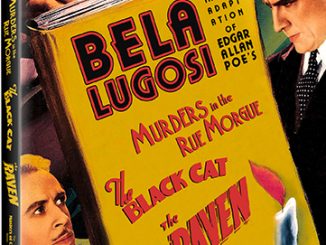

Be the first to comment